
Find more great Horn Book content at these links:
Recommended books: reviews and themed booklists
App and e-book reviews
Movie reviews
Event news and recaps
Events calendar
Recommended reading on "the circuit"
In his 1998 Boston Globe–Horn Book Award acceptance speech for The Circuit, Dr.
Primary
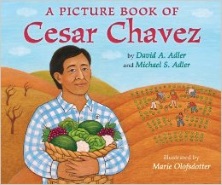 Using quotes from the subject's autobiography, David A. Adler and Michael S. Adler's A Picture Book of César Chávez tells Chávez's abbreviated life story, from migrant farm work in childhood through his life of activism to his death in 1993. Marie Olofsdotter's warm-hued illustrations reflect the man's heritage and commitment to his cause. The book's source notes and other ancillary material are excellent. (Holiday, 2010)
Using quotes from the subject's autobiography, David A. Adler and Michael S. Adler's A Picture Book of César Chávez tells Chávez's abbreviated life story, from migrant farm work in childhood through his life of activism to his death in 1993. Marie Olofsdotter's warm-hued illustrations reflect the man's heritage and commitment to his cause. The book's source notes and other ancillary material are excellent. (Holiday, 2010) Monica Brown makes a significant contribution to the increasing number of books about César Chávez by focusing equally on his partner, Dolores Huerta, in Side by Side / Lado a lado: The Story of Dolores Huerta and César Chavéz / La historia de Dolores Huerta y César Chávez. Their life stories are told in parallel until they meet and "side by side...began their journey." Huerta's accomplishments are admirable, and she gets her due in this heartfelt bilingual volume enhanced by Joe Cepeda's emotion-filled mixed-media illustrations. (HarperCollins/Rayo, 2010)
Monica Brown makes a significant contribution to the increasing number of books about César Chávez by focusing equally on his partner, Dolores Huerta, in Side by Side / Lado a lado: The Story of Dolores Huerta and César Chavéz / La historia de Dolores Huerta y César Chávez. Their life stories are told in parallel until they meet and "side by side...began their journey." Huerta's accomplishments are admirable, and she gets her due in this heartfelt bilingual volume enhanced by Joe Cepeda's emotion-filled mixed-media illustrations. (HarperCollins/Rayo, 2010)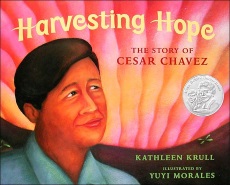 In Harvesting Hope: The Story of César Chávez, Kathleen Krull shows how Chávez developed into an advocate and spokesman for migrant workers, focusing on the march he led as part of a grape-pickers strike. The brief text creates a complex view of Chávez, and Yuyi Morales's mixed-media paintings are suffused with a variety of emotions. There are no sources, but this is an excellent choice for furthering understanding of racism, of nonviolent protest, and of the lives of workers before unions. Look for Spanish-language edition Cosechando esperanza: La historia de Cesar Chavez. (Harcourt, 2003)
In Harvesting Hope: The Story of César Chávez, Kathleen Krull shows how Chávez developed into an advocate and spokesman for migrant workers, focusing on the march he led as part of a grape-pickers strike. The brief text creates a complex view of Chávez, and Yuyi Morales's mixed-media paintings are suffused with a variety of emotions. There are no sources, but this is an excellent choice for furthering understanding of racism, of nonviolent protest, and of the lives of workers before unions. Look for Spanish-language edition Cosechando esperanza: La historia de Cesar Chavez. (Harcourt, 2003) In 1947 the Mendez family fought for — and won —the desegregation of schools in California. Author/illustrator Duncan Tonatiuh uses a child's viewpoint to succinctly capture the segregated reality of Mexican Americans in Separate Is Never Equal: Sylvia Mendez & Her Family's Fight for Desegregation. The straightforward narrative is well matched with illustrations in Tonatiuh's signature style, their two-dimensional perspective reminiscent of the Mixtec codex but collaged with paper, wood, etc. to provide textural variation. An author's note with photos is appended. (Abrams, 2014)
In 1947 the Mendez family fought for — and won —the desegregation of schools in California. Author/illustrator Duncan Tonatiuh uses a child's viewpoint to succinctly capture the segregated reality of Mexican Americans in Separate Is Never Equal: Sylvia Mendez & Her Family's Fight for Desegregation. The straightforward narrative is well matched with illustrations in Tonatiuh's signature style, their two-dimensional perspective reminiscent of the Mixtec codex but collaged with paper, wood, etc. to provide textural variation. An author's note with photos is appended. (Abrams, 2014)Intermediate
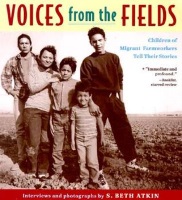 S. Beth Atkin's Voices from the Fields: Children of Migrant Farmworkers Tell Their Stories features children and teenagers of migrant workers, depicted in black-and-white photographs, speaking about family experiences, work, gangs, friends, and assorted fears, hopes, and dreams. Poetry by the young people, printed in both English and Spanish, is interspersed among the interviews. (Little, Brown, 2000)
S. Beth Atkin's Voices from the Fields: Children of Migrant Farmworkers Tell Their Stories features children and teenagers of migrant workers, depicted in black-and-white photographs, speaking about family experiences, work, gangs, friends, and assorted fears, hopes, and dreams. Poetry by the young people, printed in both English and Spanish, is interspersed among the interviews. (Little, Brown, 2000) Francisco Jiménez's The Circuit: Stories from the Life of a Migrant Child was originally published only in paperback (by University of New Mexico Press). The hardcover edition of this moving and transcendent book — which won the 1998 Boston Globe-Horn Book Award for fiction — includes an appended author's note drawn from Jiménez's acceptance speech for that award. (Houghton, 1999)
Francisco Jiménez's The Circuit: Stories from the Life of a Migrant Child was originally published only in paperback (by University of New Mexico Press). The hardcover edition of this moving and transcendent book — which won the 1998 Boston Globe-Horn Book Award for fiction — includes an appended author's note drawn from Jiménez's acceptance speech for that award. (Houghton, 1999)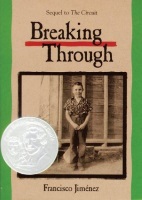 Breaking Through, Francisco Jiménez's sequel to The Circuit, follows the pattern of the coming-of-age novel. Francisco and his family obtain visas that allow them to enter and stay in the United States without fear of deportation. Like its hero, the book's pace is steady and deliberate, relying upon natural development rather than theatrics. For all its recounting of deprivation, this is a hopeful book, told with rectitude and dignity. (Houghton, 2001)
Breaking Through, Francisco Jiménez's sequel to The Circuit, follows the pattern of the coming-of-age novel. Francisco and his family obtain visas that allow them to enter and stay in the United States without fear of deportation. Like its hero, the book's pace is steady and deliberate, relying upon natural development rather than theatrics. For all its recounting of deprivation, this is a hopeful book, told with rectitude and dignity. (Houghton, 2001) In Esperanza Rising, Pam Munoz Ryan's poignant novel of the realities of immigration, thirteen-year-old Esperanza, daughter of an affluent Mexican rancher, is forced to trade fancy dolls and dresses for hard work and ill-fitting hand-me-downs after her beloved father dies. Laboring in the United States, picking grapes on someone else's land for pennies an hour, Esperanza is transformed into someone who can take care of herself and others. (Scholastic, 2000)
In Esperanza Rising, Pam Munoz Ryan's poignant novel of the realities of immigration, thirteen-year-old Esperanza, daughter of an affluent Mexican rancher, is forced to trade fancy dolls and dresses for hard work and ill-fitting hand-me-downs after her beloved father dies. Laboring in the United States, picking grapes on someone else's land for pennies an hour, Esperanza is transformed into someone who can take care of herself and others. (Scholastic, 2000)Older
 In his comprehensive history Strike!: The Farm Workers' Fight for Their Rights, Larry Dane Brimner recounts the movement for better wages and working conditions among migrant farm workers in the Southwest, from California's burgeoning need for farm workers in the twentieth century to the story of César Chávez, the United Farm Workers of America, and the Delano grape workers' strike. The compelling narrative includes both textual and visual primary sources. (Boyds Mills/Calkins, 2014)
In his comprehensive history Strike!: The Farm Workers' Fight for Their Rights, Larry Dane Brimner recounts the movement for better wages and working conditions among migrant farm workers in the Southwest, from California's burgeoning need for farm workers in the twentieth century to the story of César Chávez, the United Farm Workers of America, and the Delano grape workers' strike. The compelling narrative includes both textual and visual primary sources. (Boyds Mills/Calkins, 2014)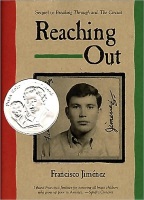 Francisco Jiménez (The Circuit, Breaking Through) continues the fictionalized story of his maturation in Reaching Out, here describing his character's college years in the early 1960s. The writing is precise and evocative, with the author's affection for family and friends being especially palpable. A quietly compelling book for older teens and an important contribution to the body of works addressing the immigrant experience. (Houghton, 2008)
Francisco Jiménez (The Circuit, Breaking Through) continues the fictionalized story of his maturation in Reaching Out, here describing his character's college years in the early 1960s. The writing is precise and evocative, with the author's affection for family and friends being especially palpable. A quietly compelling book for older teens and an important contribution to the body of works addressing the immigrant experience. (Houghton, 2008) Jeff C. Young's thorough, well-documented biography César Chávez [American Workers series] recounts Chávez's progression from fieldworker in California to activist, union organizer, and civil rights advocate. Chávez's untiring efforts, extremely modest salary, refusal to back down, hunger strikes, and growing awareness of political process are emphasized, with the United Farm Workers Union as his crowning achievement. Considerable primary material is used, and captioned photographs illustrate the text. (Morgan, 2007)
Jeff C. Young's thorough, well-documented biography César Chávez [American Workers series] recounts Chávez's progression from fieldworker in California to activist, union organizer, and civil rights advocate. Chávez's untiring efforts, extremely modest salary, refusal to back down, hunger strikes, and growing awareness of political process are emphasized, with the United Farm Workers Union as his crowning achievement. Considerable primary material is used, and captioned photographs illustrate the text. (Morgan, 2007)
RECOMMENDED
ALREADY A SUBSCRIBER? LOG IN
We are currently offering this content for free. Sign up now to activate your personal profile, where you can save articles for future viewing.







Add Comment :-
Comment Policy:
Comment should not be empty !!!
linda cordova
Very good reminds me of waiting for superman .Posted : Jun 08, 2015 09:12